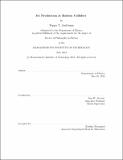| dc.contributor.advisor | Iain W. Stewart. | en_US |
| dc.contributor.author | Jouttenus, Teppo T. (Teppo Tapani) | en_US |
| dc.contributor.other | Massachusetts Institute of Technology. Dept. of Physics. | en_US |
| dc.date.accessioned | 2013-02-14T15:34:34Z | |
| dc.date.available | 2013-02-14T15:34:34Z | |
| dc.date.copyright | 2012 | en_US |
| dc.date.issued | 2012 | en_US |
| dc.identifier.uri | http://hdl.handle.net/1721.1/76979 | |
| dc.description | Thesis (Ph. D.)--Massachusetts Institute of Technology, Dept. of Physics, 2012. | en_US |
| dc.description | Cataloged from PDF version of thesis. | en_US |
| dc.description | Includes bibliographical references (p. 101-104). | en_US |
| dc.description.abstract | Hadronic jets feature in many final states of interest in modern collider experiments. They form a significant Standard Model background for many proposed new physics processes and also probe QCD interactions at several different scales. At high energies incoming protons produce beam jets. Correctly accounting for the beam and central jets is critical to precise understanding of hadronic final states at the Large Hadron Collider. We study jet cross sections as a function of the shape of both beam and central jets. This work focuses on measuring jet mass but our methods can be applied to other jet shape variables as well. Measuring jet mass introduces additional scales to the collision process and these scales produce large logarithms that need to be resummed. Factorizing the cross section into hard, jet, beam, and soft functions enables such resummation. We begin by studying jet production at e + e- collisions in order to focus on the effects of jet algorithms. These results can be carried over to the more complicated case of hadron collisions. We use the Sterman-Weinberg algorithm as a specific example and derive an expression for the quark jet function. Turning to hadron colliders, we show how the N-jettiness event shape divides phase space into N +2 regions, each containing one central or beam jet. Thus, N-jettiness works as a jet algorithm. Using a geometric measure gives central jets with circular boundaries. We then give a factorization theorem for the cross section fully differential in the mass of each jet, and compute the corresponding soft function at next-to-leading order (NLO). We use a method of hemisphere decomposition, which can also be applied to calculate N-jet soft functions defined with other jet algorithms. Our calculation of the N-jettiness soft function provides the final missing ingredient to extend NLO cross sections to resunmmed predictions at next-to-next-to-leading logarithmic order. We study the production of an exclusive jet together with a Standard Model Higgs boson. Based on theoretical reasons and agreement between our calculation and data from the ATLAS collaboration, we argue that our results for the jet mass spectrum are a good approximation also for inclusive jet production and other hard processes. | en_US |
| dc.description.statementofresponsibility | by Teppo T. Jouttenus. | en_US |
| dc.format.extent | 104 p. | en_US |
| dc.language.iso | eng | en_US |
| dc.publisher | Massachusetts Institute of Technology | en_US |
| dc.rights | M.I.T. theses are protected by
copyright. They may be viewed from this source for any purpose, but
reproduction or distribution in any format is prohibited without written
permission. See provided URL for inquiries about permission. | en_US |
| dc.rights.uri | http://dspace.mit.edu/handle/1721.1/7582 | en_US |
| dc.subject | Physics. | en_US |
| dc.title | Jet production at hadron colliders | en_US |
| dc.type | Thesis | en_US |
| dc.description.degree | Ph.D. | en_US |
| dc.contributor.department | Massachusetts Institute of Technology. Department of Physics | |
| dc.identifier.oclc | 824947810 | en_US |
